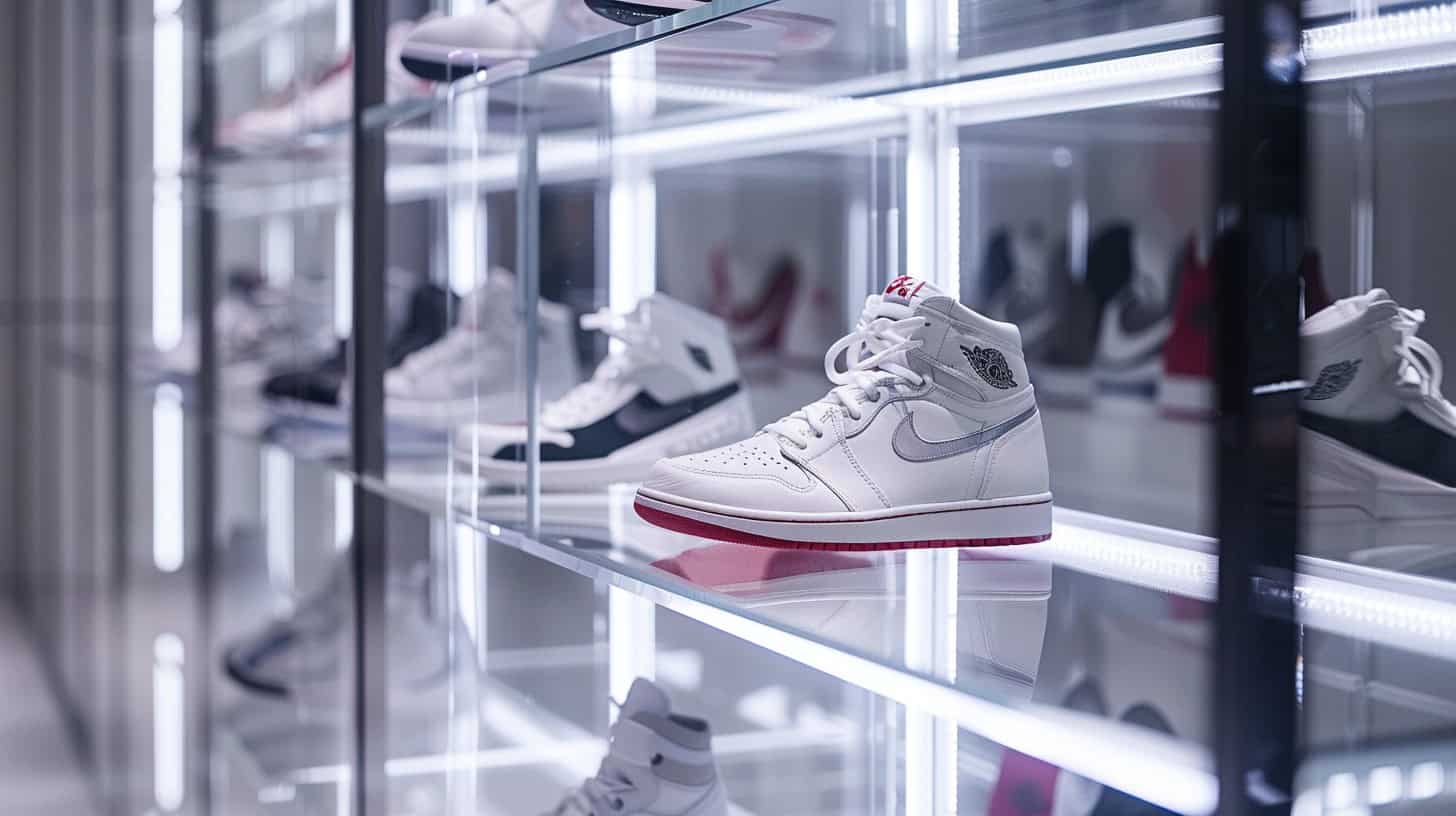Have you ever wondered about the goldmine hidden in sneaker collecting? Deadstock, or DS shoes, are a huge deal. This article will show why these never-worn treasures are so prized.
Let’s start your journey to finding the perfect pair of sneakers.
Key Takeaways
Deadstock sneakers are brand new, never worn shoes that come with their original box and sometimes still have tags on. They are very valuable to collectors because of their rarity and perfect condition.
To make sure deadstock sneakers are authentic, it’s important to check for the original box and accessories, closely inspect shoe quality, compare them with official images online, and verify serial numbers against manufacturer databases.
The term “deadstock” has been part of sneaker culture since the 1980s when sneaker collecting became popular. Rare models by big names like Michael Jordan or Kanye West have made these items highly sought after.
Sneakers labeled as deadstock can fetch high prices in the resale market due to their limited availability, cultural significance, historical importance, and condition. This makes some of them good investments.
When searching for genuine deadstock sneakers, buyers should look for pristine soles, flawless fabric or leather uppers, correct packaging, included accessories specific to the pair, and consider shopping from reputable sellers or platforms that verify authenticity.
Table of Contents
Exploring Deadstock in the World of Sneakers
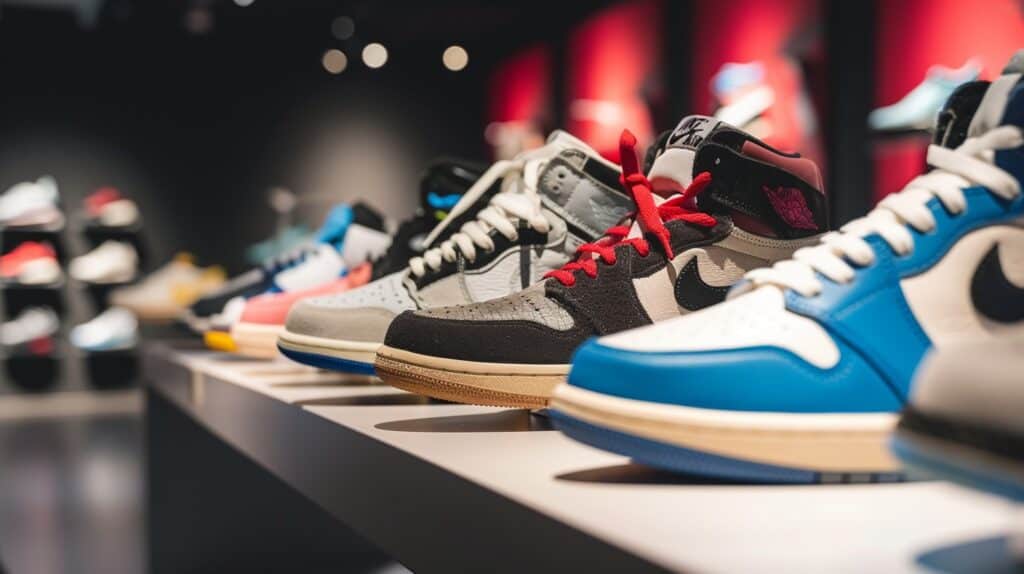
Deadstock sneakers are brand-new shoes that never hit the streets. They come with their original box and sometimes have the tags still on.
Features of Deadstock Sneakers
Deadstock sneakers are like hidden treasures in the sneaker world. They bring joy to collectors and sneakerheads alike with their uniqueness and value.
- Sneakers are brand new and never worn, making them highly sought after in the sneaker culture.
- Each pair comes in its original packaging, complete with box, box lid, and size label, which adds to their appeal among collectors.
- Deadstock shoes often come with all included accessories, ensuring buyers receive a full set as if they were purchasing directly from a retailer.
- Rarity and exclusivity play a big role in their high market value, attracting both collectors aiming to expand their sneaker collection and investors looking for valuable assets.
- Limited-edition releases make these sneakers even more special because they’re not easy to find on the regular retail market.
- The condition of deadstock sneakers is impeccable; they have no signs of wear, preserving the artistry of the shoe design.
- Verifying authenticity is crucial; genuine DS shoes should match exact details from manufacturers like Nike or Adidas.
- Historically significant models, such as Air Jordans or Yeezys, often become deadstock items due to their popularity and limited availability at launch.
- Collectors prize these sneakers not just for wearing, but also as pieces of history within the sneaker-collecting community and streetwear culture.
I found my perfect pair of deadstock sneakers after months of searching through online stores and auction sites like eBay. It’s challenging yet exciting to hunt for these rare finds that once seemed out of reach.
Verifying Authenticity and Rarity
Checking if your sneakers are authentic and rare is vital. Real deadstock shoes have special traits that counterfeit one’s lack.
- Look for the original box and accessories. Deadstock sneakers should come with everything they originally included, like extra laces or a certificate of authenticity.
- Inspect the shoe quality closely. Fake products often have poor stitching or off colors.
- Compare the sneakers with official images online. Brands like Nike and New Balance share pictures of their products on their websites.
- Check the sneaker’s serial number against the manufacturer’s database if possible. This can verify if the pair was genuinely made by the brand.
- Seek advice from expert sneaker collectors in forums or communities dedicated to sneakerhead culture.
- Use reputable retailers or resale platforms like StockX for purchases, which authenticate items before selling them.
- Pay attention to price points. If the deal seems too good to be true, it probably isn’t genuine deadstock.
- Trust your gut feeling, but support it with thorough research and expert opinions.
I once doubted a pair of basketball shoes claiming to be rare Nike Air Jordans because their price was unusually low compared to market value—a clear red flag for counterfeits.
For those interested in high-quality footwear beyond sneakers, check out SASnola.com for a wide selection manufactured in Texas, plus enjoy free shipping on orders over $99.
Let’s move on to understanding the historical significance behind deadstock sneakers and how they’ve shaped collector behavior over time.
The Historical Importance of Deadstock Sneakers
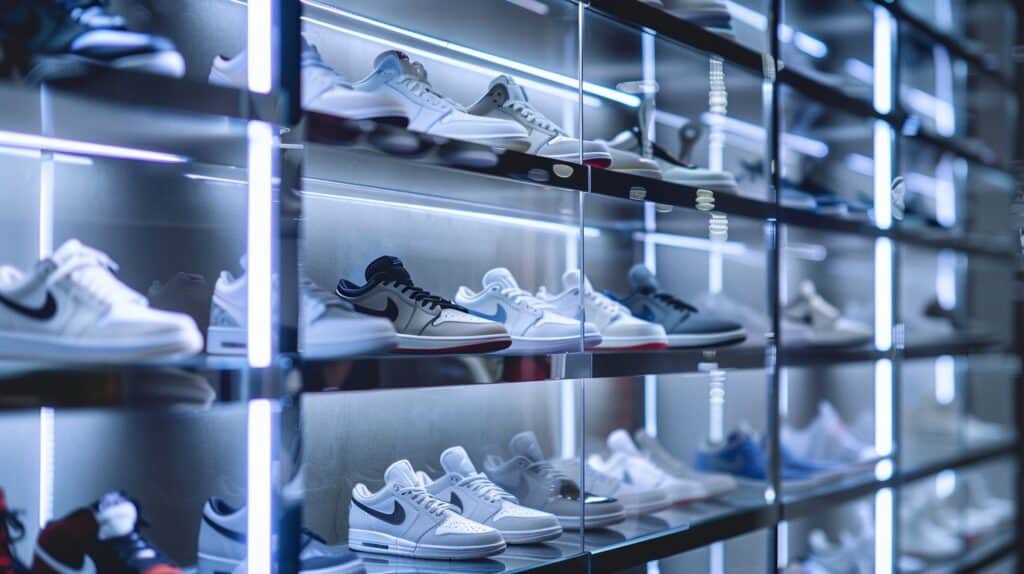
Deadstock sneakers have a rich past that changed how we see shoes today. They started as rare finds but grew to shape sneaker collecting culture.
The Origins and Development
Sneaker culture took off in the 1980s, the time when the first mainstream sneakers danced onto the scene. This era marked a huge shift. Men everywhere started chasing after these shoes, longing for that perfect pair to show off.
It wasn’t just about having any shoe; it was about finding those rare gems, no longer sitting on shelves or being made. Words like “deadstock” became part of everyday talk among sneaker fans.
The term deadstock might sound new to some, but hunting for unworn, exclusive kicks is an old game.
My buddy once found a pair of Air Jordan 1s hidden away in his uncle’s closet. They were from the ’80s and untouched—real deadstock gold. He said it felt like uncovering treasure.
That moment showed me how deep people get into this hunt and why “deadstock” means so much more than just unsold shoes. It’s about landing that one-in-a-million find that connects you back to sneaker history‘s golden days.
Influence on Sneaker Collecting
Deadstock sneakers have changed how men collect shoes. These rare finds, like those from Michael Jordan and Kanye West, make collectors’ hearts race. They show off unique designs not found in regular stores, making every pair a treasure hunt.
Collectors pride themselves on hunting these limited editions, boosting their status in the sneaker community.
This chase also shapes the resale market. Prices soar as demand increases for these exclusive kicks. Sneaker resellers play a big role, using proxies to buy limited pairs and selling them at higher prices for profit.
This has turned some collections into valuable investments over time. Next up, let’s talk about how deadstock sneakers impact their market value.
The Market Value of Deadstock Sneakers
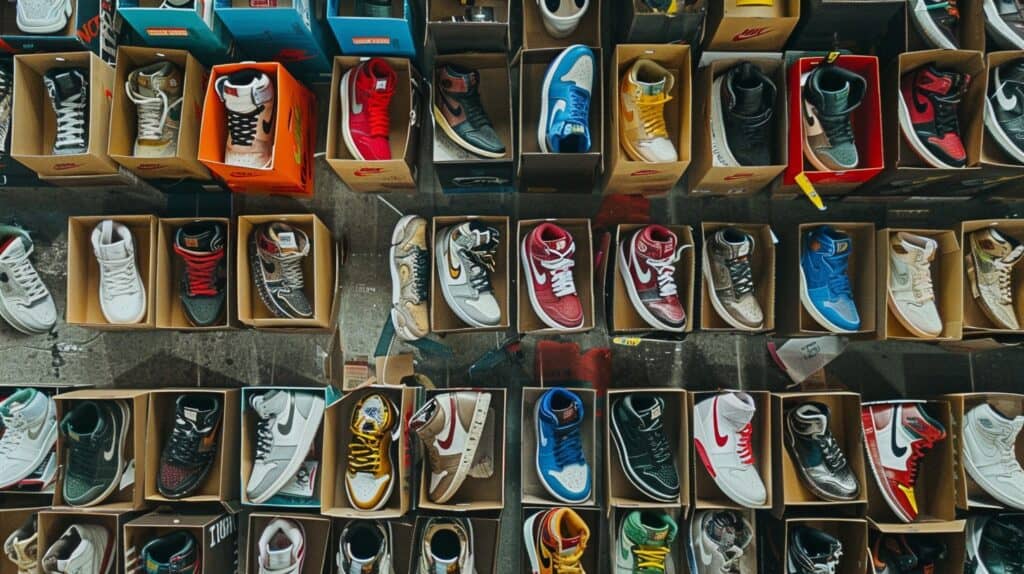
Deadstock sneakers often fetch high prices on the market. This is because they are rare and in perfect condition, making them very desirable to collectors and sneaker fans.
Reasons for High Value
Deadstock sneakers hold a special place in footwear. They are unique because they have never been worn and come in their original packaging.
- Rarity and Exclusivity: Deadstock shoes are rare finds. Their limited availability makes them highly desirable among collectors.
- Cultural Significance: Shoes tied to icons like Michael Jordan or Kanye West carry stories that fans value deeply.
- Historical Importance: Older models signify key moments in sports and fashion history, adding to their appeal.
- Limited Editions: Many deadstock sneakers were released in small numbers, so owning a pair is like having a piece of history.
- High Demand in the Resale Market: Collectors are willing to pay top dollar for shoes they missed out on during the original release.
- Quality and Condition: Being unworn, these sneakers are in perfect condition, making them more valuable than used pairs.
- Investment Potential: Some rare sneakers have sold for five figures, proving their worth as investments.
- Brand Loyalty: Fans of brands like Nike’s Jordan brand often seek out deadstock versions of their favorite shoes to complete their collections.
Let’s explore how you can spot genuine deadstock sneakers next.
Dynamics of the Sneaker Resale Market
The sneaker resale market thrives on supply and demand. Sites like StockX and Stadium Goods have changed how men buy sneakers. These platforms let buyers find deadstock shoes from brands like Nike and Reebok without leaving their homes.
They offer a wide range of prices, making it easier to invest in rare sneakers. I searched for a perfect pair of low-top Nikes and found them on StockX within minutes. It felt like hitting the jackpot.
Selling on these sites is just as straightforward. You list your unworn shoes, set your price, and wait for buyers. Digital auctions at Sotheby’s also attract collectors looking for vintage or unique finds.
This digital shift means more people can join the sneaker collecting game.
Digital markets transform how we view and trade deadstock sneakers.
Now let’s look at how to spot authentic deadstock sneakers.
How to Identify Authentic Deadstock Sneakers
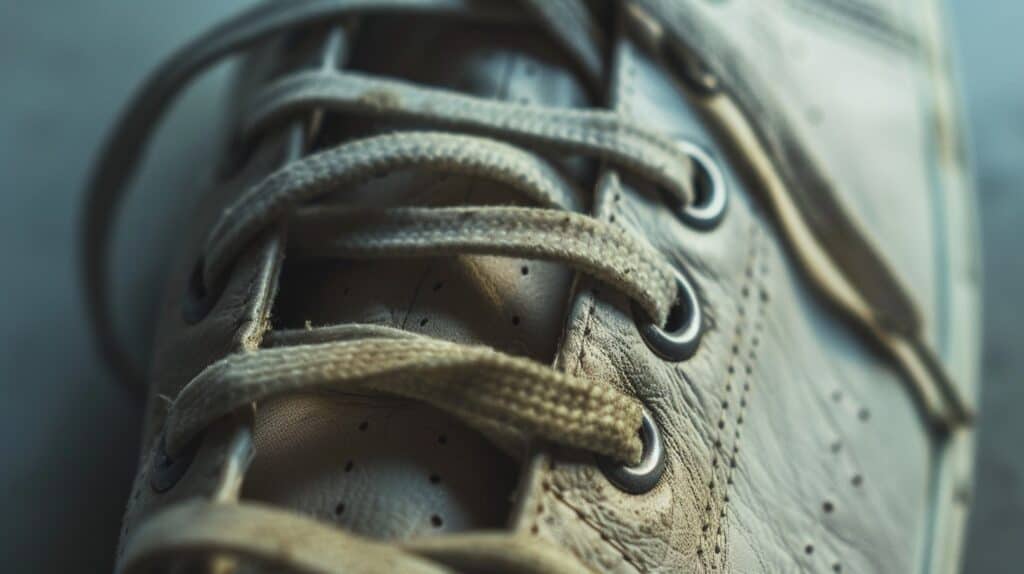
To spot real deadstock sneakers, check for clean and untouched soles. Be cautious of sellers who don’t offer returns or warranties; genuine products often come with these protections.
Signs of Genuine Deadstock
Deadstock sneakers hold a special place in the shoe world. They are brand-new, never worn, and come straight from the box.
- Check for the original box and label. Real deadstock sneakers will have their original box with a clear lid and a label that lists the shoe size and other details.
- Look for included accessories. These shoes often come with extra laces, branded tissue paper, or other specific items meant only for those pairs.
- Examine the condition of the soles. The soles of genuine deadstock sneakers will show no signs of wear; they should be pristine and untouched.
- Inspect the uppers carefully. The fabric or leather on deadstock shoes will be flawless without any stains or creases from wear.
- Make sure there is no discoloration. Over time, even unworn vintage shoes can start to break down and change color; deadstock means they have been perfectly preserved.
6: Search for limited-edition packaging. Many deadstock sneakers are limited releases and might have unique boxes or extras that regular models don’t include.
7: Trust only reputable sellers. Buy from well-known stores like Foot Locker or verified platforms to avoid fakes.
8: Use serial numbers to verify authenticity. Every pair of Nike’s, for instance, has a unique serial number that you can check against official records.
9: Beware of too-good-to-be-true prices. Deadstock sneakers are rare and highly valued, so if the price seems very low, it might not be authentic.
These steps ensure you get your hands on real sneaker gold without falling for common mistakes or myths in the market.
Common Mistakes and Myths
Men often mix up terms in the sneaker world. Here, we clear up some common mistakes and myths about deadstock sneakers.
- Misidentifying slightly worn shoes as deadstock because they look new can lead you astray. Always check for any signs of wear.
- Thinking every limited-edition shoe is deadstock without checking its condition is a mistake. Verify it first.
- Assuming a high resale price means the shoe is deadstock isn’t accurate. Prices can be high for reasons other than being unworn.
- Believing that all deadstock shoes are in mint condition ignores age’s effect on materials. Some might show signs of degradation even if never worn.
- Many think deadstock status requires original packaging and accessories to be true. This isn’t always the case, though it helps with authenticity.
- Looking at a listing that says “deadstock” and not verifying with pictures or physical checks can lead to disappointment. Always ask for proof.
- Skipping the step to read the terms of service and warranty disclaimers from platforms like eBay or Sotheby’s could leave you unprotected if issues arise.
- Forgetting to use tools like analytics from e-commerce sites lowers your chance of spotting fakes or overpriced listings.
- misunderstanding that original insoles and midsoles must always be present for a shoe to qualify as deadstock overlooks replacements due to deterioration over time.
- Dodging research on proper storage conditions for sneakers affects how you judge a pair’s status as deadstock; incorrect storage can lead to unseen damage.
Understanding these points helps clarify what truly makes a sneaker “deadstock” and guides men in making informed decisions in their quest for the perfect pair of shoes, whether they’re looking into investing, marketing, or simply expanding their collection with genuine treasures of sneaker gold
People Also Ask
What does deadstock mean?
Deadstock means the shoes are new, not used, and still have their original packaging. They haven’t been worn outside or tried on frequently.
Why do people want deadstock shoes?
Collectors value them because they are rare and in perfect condition. This scarcity makes them more desirable, similar to a scarce commodity in the stock market.
Can you wear deadstock sneakers?
Yes, you can wear them, but doing so might decrease their value if you’re looking to sell them later, as they won’t be considered ‘deadstock’ anymore.
How do I know if my shoes are truly deadstock?
Check for any signs of wear or damage, ensure they come with their original box and accessories, like crew socks if applicable; this helps verify their status.
Where can people buy or sell deadstock sneakers?
Platforms like eBay offer a marketplace for buying and selling these rare finds through auctions or direct sales.
Are there risks when buying deadstock shoes online?
Yes, buyers should be aware of potential scams or counterfeit products. Always buy from reputable sources and check seller reviews before making a purchase.
